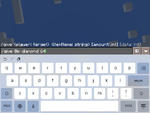| Commands | |
|---|---|
 Example of Give Command | |
|
Type |
Technical |
|
In Game |
40 Commands |
|
First Appearance |
Update 0.16.0 |
Commands (AKA Cheats) are actions entered by the Player which make a certain action occur in Minecraft automatically. Commands were added in Update 0.16.0.
Usage
Commands are mostly used to make any action in-game happen automatically, such as Mob spawning, Block placing, inflicting Status Effects, teleporting, etc.
To execute a command The Player must enter Chat, precede the command with a forward slash, give the arguments and hit the return key. For devices having the Tab-key, it can be used to complete parts of the commands. When typing, possible completion will show.
Commands can also be used by entering them in a Command Block.
Note that for Commands to work, "Cheats" needs to be enabled, which in turn will disable achievements. To turn on cheats, go to Settings > Game > Cheats: On.
List of Commands
For a more detailed list, see here.
The current commands in Minecraft Pocket Edition are-
/alwaysdayor/daylock- Locks and unlocks the day-night cycle/clear- Clears The Player's inventory/clone– Copies blocks from one place to another/connect- connects to a server in-game (Update 1.0)/deop– Revoke operator status from a player/difficulty- Changes the difficulty/effect- Grants a status effect to an entity/enchant– Enchants a player's item/execute– Executes another command/fill– Fills a region with a specific block/gamemode– Sets a player's game mode/gamerule– Sets a game rule value/give– Gives an item to a player/help– Provides help for commands/kill– Kills entities (players, mobs, items, etc.)/list– Lists players on the server/locate- Locates the nearest selected structure (Update 1.0)/me- Displays custom chat message starting with player's name./mixer- Mixer interactivity control/op– Grants operator status to a player/playsound– Plays a built-in sound/replaceitem– Replaces inventory items/say– Displays a message to multiple players/setmaxplayers– Sets the maximum number of players for the current game session/setblock– Changes a block to another block/setworldspawn– Sets the world spawn/spawnpoint– Sets spawn point for a player/spreadplayers– Teleports entities to random locations within a radius/stopsound– Stops a currently playing sound/summon– Summons an entity/tell|/msgor/w– displays a private message to other players/testfor– Tests for a player or other entity/testforblock– Tests whether a block is in a location/testforblocks– Tests whether the blocks in two regions match/tickingarea– Sets areas that update without any Players in them/time– Changes or queries the world's game time/title– Displays screen titles/toggledownfall– Toggles the weather/tpor/teleport]]– Teleports entities/transferserver— Transfer into another server in-game/weather– Sets the weather/wsserver– Connects to WebSocket servers. Used by developers/xp– Adds or removes player experience
Command arguments
Most commands accept arguments, i.e.,<player: target> where the first part indicates what the arguments refer to, and the second part refers to the type of argument. In the example given a Player identifies a player by using a target type argument. The different types of arguments are described in this section.
string
Any combination of alphanumeric characters.
int
A number, which might have range associated with it. Negative numbers are possible. Positional counts are zero-based - e.g., the first slot in a player's 36-slot inventory is referred to in commands as zero and the last is 35.
x y z
A coordinate set of int's denoting a coordinate. The x value indicates distance towards the East from the origin. The y value indicates height above bedrock. The z value indicates distance towards North from the origin. Note that to use The Player's position one can use tilde '~' or caret '^' offsets. I.e. the command /tp ~5 ~ ~-10 would move The Player 5 meters/blocks to the East, keep the height, and 10 meters/blocks to the South (as it is a negative offset), and /tp ^5 ^ ^-10 would move The Player 5 meters/blocks to the player's perceived right, keep the height, and 10 meters/blocks backward (as it is a negative offset).
Target
Instead of specifying coordinates, some commands allow specifying a target. This can relate both to players and entities.
@a– All players
@e– All entities
@p– Nearest players
@r– Random player(s)@s– Yourself
These selector arguments can be further specified using text like in /kill @e[type=cow,r=10] which would kill all cows within a radius of 10 meters/blocks.
Trivia
- Commands have been used in many Multiplayer Servers even before they were officially released. However, this was done through Plugins.
- Commands were originally slated for Update 0.15.0, however, they were not added.
- As of Update 1.2 common commands have a User interface in Chat.
- In the Update 1.0.5 Beta, there was a
/particlecommand. However. it was removed due to functional issues, and the update it returns in has not been confirmed.
